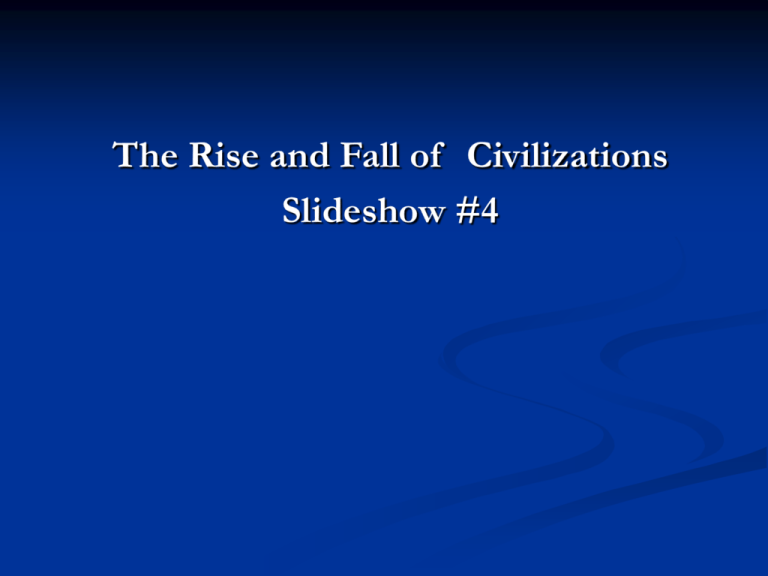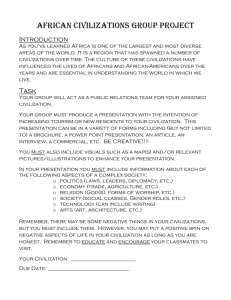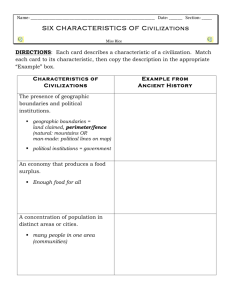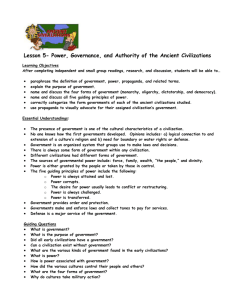Slide Show #4
advertisement

The Rise and Fall of Civilizations Slideshow #4 Focus Questions for Chapter 4 and Assigned readings 1. 2. 3. 4. 5. 6. 7. 8. WHY WERE the Hittite, Cretan, and Mycenaean states more fragile than the great river-valley civilizations? WHAT FUNDAMENTAL problems did all large ancient civilizations face? WHAT factor drove the growth of Indus/Harrapan civilization according to “The Indus Riddle” article? Why? WHY DID Harappan civilization disappear? WHAT elements of Harrapan civilization/Indus culture continue on in this region of present-day India/Pakistan? WHAT WERE the continuities between the Shang and the Zhou in China? WHERE DID the first states arise in the New World? WHY WERE Egypt and China able to survive when other ancient civilizations collapsed around 1000 B.C.E.? Why did Chinese and Egyptian civilization survive and evolve, while the Hittite Empire and others collapsed by 1000 B.C.E.? Economic factors: wealth, trade and need for imports Political factors: government, role of king Religious factors: belief system, connections between politics and religion Environmental factors: stability of environment, natural boundaries See link to online “Connections/Summary Tables” Factors influencing civilizations that collapsed by 1000 B.C.E.: Hittite Empire Economic: crossroads of trade-- metals and textiles, need for expansion Political: monarchy, complex bureaucracy for collection of taxes, regulation of trade and agricultural production, running the military Religious: king believed to be descended from sun god Environmental: high plateau, lack of rainfall, hot and dry summers, cold winters, easy exposure to invaders Military/technological: use of bronze chariots, weapons for raids/warfare Minoan Crete Economic: little arable land, need for imports, hub of trade for the Eastern Mediterranean, Aegean seas Political: details unknown, “palaces” (ie. Knosssos) as centers for storage and redistribution of wealth, controls agricultural production Religious: details unknown, cult centers existed in “palaces,” also on mountain peaks, in caves, and elsewhere Environmental: surrounded by sea, prone to earthquakes and subject to nearby volcanic activity; little arable land One measure of the influence of the Hittites is the durability of their art. This relief, from Carchemish in Phoenicia, dates from at least two centuries after the Hittite empire collapsed, but illustrates the Hittite focus on chariot warfare. Also, the winged sun was a symbol other regional empires adopted. Knossos. Frescoes on the palace walls of Knossos, Crete, from about 1500 B.C.E. Dolphins were favored as food for elite feasts. The palace—at once an elite dwelling, religious site and a storehouse and distribution center for food—was rebuilt many times between destructions by earthquakes and, perhaps, invasions. The palace was was also important as the source of the myth of the Labyrinth. Knossos, Crete Palace of Knossos, Crete, c. 1500 CE (the Labyrinth?) Myth of the Labyrinth A mazelike structure designed and built by skilled craftsmen and inventor Daedalus for King Minos of Crete to hold the Minotaur, a half-man, half-bull. Daedalus’s design was so cunning that he almost became lost himself after he finished building it. After defeating the Athenians in a war, King Minos decreed that every seven years, seven Athenian boys and seven Athenian girls would be sent to the labyrinth to be eaten by the Minotaur. On the third round of this cycle of sacrifice, the hero Theseus (future king of Athens) volunteered to go to Crete and kill the monster. Theseus was aided by Ariadne, daughter of King Minos, who gave him a ball of thread (the “clew” or “clue”) to find his way out of the labyrinth. Ariadne also furnished him with a sword, and instructions (“always go forward, always go down, never left or right”). Theseus made his way to the center of the maze, stumbled on a rock, awakening the sleeping Minotaur, and began a bloody fight., in which he eventually prevailed by slitting the beast’s throat. Factors influencing civilizations that collapsed by 1000 B.C.E.: Mycenaean Greece: Peloponnese peninsula Economic: restricted arable land, need for imports, trade with rest of Eastern Mediterranean, Aegean seas Political: monarchy, “palaces” functioned as storage and redistribution centers, control over military, agricultural production Religious: cult controlled from palaces Environmental: hot, dry summers; cold, wet winters; drought conditions common; and earthquake-prone Harappan Culture in Indus River Valley Economic: widespread trade, largely self-sufficient; considerable arable land Political system: unknown (centralization obvious) Religious: details unknown Environmental: some natural boundaries, but earthquake-prone; monsoon Crete/Mycenae Timeline The Eastern Mediterranean, ca. 2000—1200 B.C.E. Mycenae defenses The walls of Mycenae in southern Greece, built over 3,000 years ago. Warlike city-states arose in this region of sparse agricultural productivity, on the profits of the manufacture and export of luxuries for markets in Egypt and Anatolia. After 1500 B.C.E., the language of Mycenae replaced that of Crete in official Cretan records, suggesting political/military mastery b the Mycenaeans. The Decline of Harappan Civilization The walled mounds of Mohenjodaro, a major Harappan city abandoned in the late second millennium B.C.E. The walls were a defense against floods, not invaders. None of the “massacre victims” identified by archaeologists in the 1940s died by violence. Rather, a slow decline of population, a gradual impoverishment of material culture, and a relentless increase in disease set in as the river Saraswati dried up. Comparisons with China and Egypt-Important Factors: China Economic: fertile soil, ample timber, two ecological zones (Yellow River, Yangtze River) providing diverse crops, loess Political system: king connected with spirit world via oracles (Shang dynasty), later through Mandate of Heaven Religious: ancestor worship, belief in connection of ruler to heaven, ruler is “Son of Heaven” Environmental: earthquakes and prone to flooding; large, diverse ecological zones, deserts, mountain ranges, and distance separate/protect from invaders Egypt Economic: wealth from agriculture, precious metals, natural supplies of building stone and copper, trade with outside for timber Political system: rule by a god-king, rigid hierarchy Religious: god-king provides balance (ma’at) that ensures prosperity Environmental: regular annual flooding of Nile provides natural fertilization (“black earth”) and watering of soil; deserts (“red earth”) provide natural barriers against invaders What are most important elements that distinguish civilizations that survived? Natural barriers against invaders Reliable agriculture, predictable harvests, fertile abundant soil Self-sufficiency; Less need for imports Divine or semi-divine kingship Playing Defense: Egypt vs. “ Sea Peoples” Sea Peoples. “Now the northern peoples in their isles were quivering in their bodies,” says the inscription that accompanies a ship-borne battle scene of the reign of Ramses III. “They penetrated the channels of the mouths of the Nile. . . . They are capsized and overwhelmed where they stand. . . . Their weapons are scattered on the sea.” Wall painting in the tomb of the vizir Rekhmire—one of hundreds of Egyptian nobles buried in sumptuous graves in Thebes circa 1500 B.C.E. Part of Rekhmire’s job was to receive “tribute” or, in effect, trade samples from foreign lands. Items depicted here include copper ingots with handles from the eastern or northern shores of the Mediterranean and exotic products from the Nubian frontier—ivory, apes, a giraffe. Egypt and Nubia, ca. 1500 B.C.E. Zhou China Early Civilizations in the Americas: What were the important factors influencing development? Economic: agricultural variety, trade routes, gold, metalworking Political: centralized coordination of food production, irrigation, Religious: widespread sacrificial rituals, ceremonial complexes Environmental: upland, swamps, proximity to oceans, rivers Did civilizations in the Andes and/or Mesoamerica have the following characteristics? Natural barriers against invaders Reliable agriculture, predictable harvests, fertile abundant soil Self-sufficiency; Less need for imports Divine or semi-divine kingship Cerro Sechín. As urban life and monumental building spread upland from the river valleys of coastal Peru in the second millennium B.C.E., warfare and rites of human sacrifice spread with them. Walls at Cerro Sechín are carved with scenes of warriors overseeing the severed heads and cleft bodies of their victims. Figure 4.1 The Andean Environment packs tremendous ecological diversity into a small space, with various climatic zones at different attitudes, contrasting micros-climates in the valleys, and tropical forest and the ocean close to hand. Maize grows on low slopes, coca and sweet potatoes above it, and potatoes at higher altitudes. The high grassland called puna provides grazing for llamas and their kin. Thematic Question Are we headed for another environmental disaster? Consider Early civilizations could cause more environmental change than they could effectively deal with and collapsed. This pattern was repeated in many different settings. Today, global warming seems to be another case of the same phenomenon, but without any other place to go. Are we headed for a major collapse of our civilization? If so, what are our prospects for recovery, given the global scale of the problem compared to those of early civilizations?






